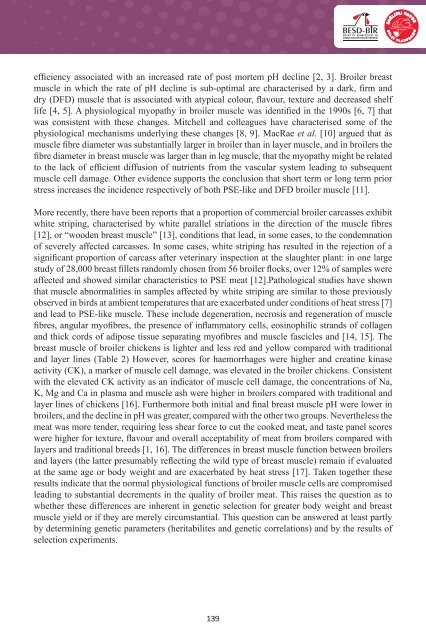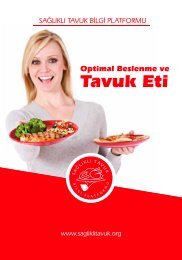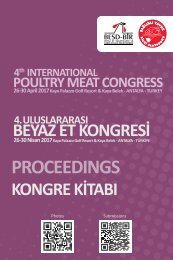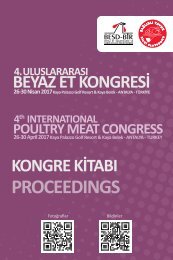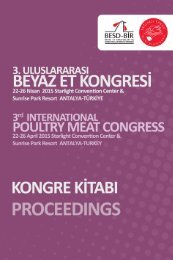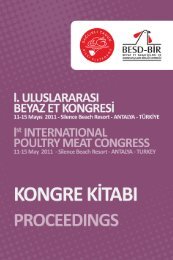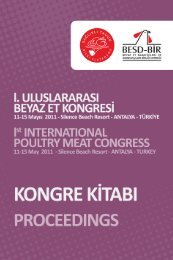3rd International Poultry Meat Congress
Proceedings
Proceedings
Create successful ePaper yourself
Turn your PDF publications into a flip-book with our unique Google optimized e-Paper software.
efficiency associated with an increased rate of post mortem pH decline [2, 3]. Broiler breast<br />
muscle in which the rate of pH decline is sub-optimal are characterised by a dark, firm and<br />
dry (DFD) muscle that is associated with atypical colour, flavour, texture and decreased shelf<br />
life [4, 5]. A physiological myopathy in broiler muscle was identified in the 1990s [6, 7] that<br />
was consistent with these changes. Mitchell and colleagues have characterised some of the<br />
physiological mechanisms underlying these changes [8, 9]. MacRae et al. [10] argued that as<br />
muscle fibre diameter was substantially larger in broiler than in layer muscle, and in broilers the<br />
fibre diameter in breast muscle was larger than in leg muscle, that the myopathy might be related<br />
to the lack of efficient diffusion of nutrients from the vascular system leading to subsequent<br />
muscle cell damage. Other evidence supports the conclusion that short term or long term prior<br />
stress increases the incidence respectively of both PSE-like and DFD broiler muscle [11].<br />
More recently, there have been reports that a proportion of commercial broiler carcasses exhibit<br />
white striping, characterised by white parallel striations in the direction of the muscle fibres<br />
[12], or “wooden breast muscle” [13], conditions that lead, in some cases, to the condemnation<br />
of severely affected carcasses. In some cases, white striping has resulted in the rejection of a<br />
significant proportion of carcass after veterinary inspection at the slaughter plant: in one large<br />
study of 28,000 breast fillets randomly chosen from 56 broiler flocks, over 12% of samples were<br />
affected and showed similar characteristics to PSE meat [12].Pathological studies have shown<br />
that muscle abnormalities in samples affected by white striping are similar to those previously<br />
observed in birds at ambient temperatures that are exacerbated under conditions of heat stress [7]<br />
and lead to PSE-like muscle. These include degeneration, necrosis and regeneration of muscle<br />
fibres, angular myofibres, the presence of inflammatory cells, eosinophilic strands of collagen<br />
and thick cords of adipose tissue separating myofibres and muscle fascicles and [14, 15]. The<br />
breast muscle of broiler chickens is lighter and less red and yellow compared with traditional<br />
and layer lines (Table 2) However, scores for haemorrhages were higher and creatine kinase<br />
activity (CK), a marker of muscle cell damage, was elevated in the broiler chickens. Consistent<br />
with the elevated CK activity as an indicator of muscle cell damage, the concentrations of Na,<br />
K, Mg and Ca in plasma and muscle ash were higher in broilers compared with traditional and<br />
layer lines of chickens [16]. Furthermore both initial and final breast muscle pH were lower in<br />
broilers, and the decline in pH was greater, compared with the other two groups. Nevertheless the<br />
meat was more tender, requiring less shear force to cut the cooked meat, and taste panel scores<br />
were higher for texture, flavour and overall acceptability of meat from broilers compared with<br />
layers and traditional breeds [1, 16]. The differences in breast muscle function between broilers<br />
and layers (the latter presumably reflecting the wild type of breast muscle) remain if evaluated<br />
at the same age or body weight and are exacerbated by heat stress [17]. Taken together these<br />
results indicate that the normal physiological functions of broiler muscle cells are compromised<br />
leading to substantial decrements in the quality of broiler meat. This raises the question as to<br />
whether these differences are inherent in genetic selection for greater body weight and breast<br />
muscle yield or if they are merely circumstantial. This question can be answered at least partly<br />
by determining genetic parameters (heritabilites and genetic correlations) and by the results of<br />
selection experiments.<br />
139


